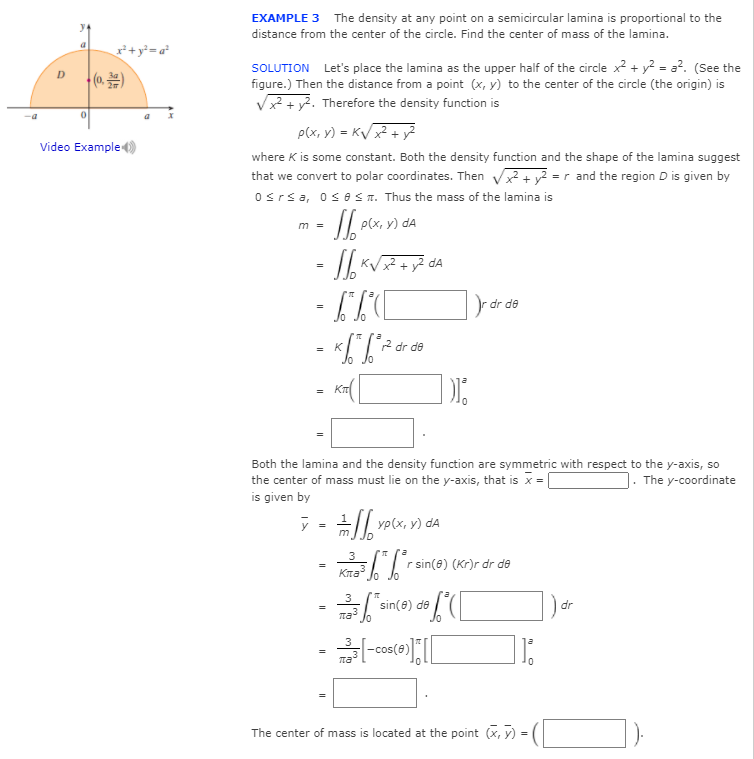EXAMPLE 3 The density at any point on a semicircular lamina is proportional to the distance from the center of the circle. Find the center of mass of the lamina. + y² = a° SOLUTION Let's place the lamina as the upper half of the circle x? + y? = a?. (See the figure.) Then the distance from a point (x, y) to the center of the circle (the origin) is V? + y?. Therefore the density function is (0, ) D p(x, y) = K/x? + y? Video Example ) where K is some constant. Both the density function and the shape of the lamina suggest that we convert to polar coordinates. Then Vx + y² = r and the region D is given by osrsa, oses n. Thus the mass of the lamina is p(x, y) dA m - dA dr de K 2 dr o Jo Jo Both the lamina and the density function are symmetric with respect to the y-axis, so the center of mass must lie on the y-axis, that is x = [ is given by 1. The y-coordinate 3 Kra r sin(e) (Kr)r dr de ma3 sin(@) de or dr cos(@ The center of mass is located at the point (x, y) =
EXAMPLE 3 The density at any point on a semicircular lamina is proportional to the distance from the center of the circle. Find the center of mass of the lamina. + y² = a° SOLUTION Let's place the lamina as the upper half of the circle x? + y? = a?. (See the figure.) Then the distance from a point (x, y) to the center of the circle (the origin) is V? + y?. Therefore the density function is (0, ) D p(x, y) = K/x? + y? Video Example ) where K is some constant. Both the density function and the shape of the lamina suggest that we convert to polar coordinates. Then Vx + y² = r and the region D is given by osrsa, oses n. Thus the mass of the lamina is p(x, y) dA m - dA dr de K 2 dr o Jo Jo Both the lamina and the density function are symmetric with respect to the y-axis, so the center of mass must lie on the y-axis, that is x = [ is given by 1. The y-coordinate 3 Kra r sin(e) (Kr)r dr de ma3 sin(@) de or dr cos(@ The center of mass is located at the point (x, y) =
Algebra & Trigonometry with Analytic Geometry
13th Edition
ISBN:9781133382119
Author:Swokowski
Publisher:Swokowski
Chapter4: Polynomial And Rational Functions
Section4.2: Properties Of Division
Problem 53E
Related questions
Question

Transcribed Image Text:EXAMPLE 3
The density at any point on a semicircular lamina is proportional to the
distance from the center of the circle. Find the center of mass of the lamina.
*+ y² = a*
SOLUTION Let's place the lamina as the upper half of the circle x? + y? = a?. (See the
figure.) Then the distance from a point (x, y) to the center of the circle (the origin) is
V + y². Therefore the density function is
p(x, y) = KV + y?
Video Example )
where K is some constant. Both the density function and the shape of the lamina suggest
that we convert to polar coordinates. Then V+ y? = r and the region D is given by
Osrsa, oseS T. Thus the mass of the lamina is
m =
p(x, y) dA
2 dA
- LLC
r dr de
K
2 dr de
Jo Jo
KT
Both the lamina and the density function are symmetric with respect to the y-axis, so
the center of mass must lie on the y-axis, that is x =|
. The y-coordinate
is given by
yo(x, v) dA
3
r sin(8) (Kr)r dr de
=
Kina
3
sin(e) de
Jo
dr
3
-cos(a)
The center of mass is located at the point (x, y) =
Expert Solution
This question has been solved!
Explore an expertly crafted, step-by-step solution for a thorough understanding of key concepts.
This is a popular solution!
Trending now
This is a popular solution!
Step by step
Solved in 2 steps with 3 images

Knowledge Booster
Learn more about
Need a deep-dive on the concept behind this application? Look no further. Learn more about this topic, calculus and related others by exploring similar questions and additional content below.Recommended textbooks for you

Algebra & Trigonometry with Analytic Geometry
Algebra
ISBN:
9781133382119
Author:
Swokowski
Publisher:
Cengage

Functions and Change: A Modeling Approach to Coll…
Algebra
ISBN:
9781337111348
Author:
Bruce Crauder, Benny Evans, Alan Noell
Publisher:
Cengage Learning

Algebra & Trigonometry with Analytic Geometry
Algebra
ISBN:
9781133382119
Author:
Swokowski
Publisher:
Cengage

Functions and Change: A Modeling Approach to Coll…
Algebra
ISBN:
9781337111348
Author:
Bruce Crauder, Benny Evans, Alan Noell
Publisher:
Cengage Learning